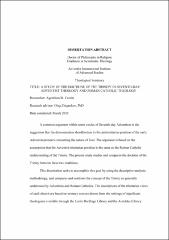A Study of the doctrine of the Trinity in Seventh-day Adventist theology and Roman Catholic theology
Abstract
A common argument within some circles of Seventh-day Adventism is the
suggestion that the denomination should return to the antitrinitarian position of the early
Adventist pioneers concerning the nature of God. The argument is based on the
assumption that the Adventist trinitarian position is the same as the Roman Catholic
understanding of the Trinity. The present study studies and compares the doctrine of the
Trinity between these two traditions.
This dissertation seeks to accomplish this goal by using the descriptive-analysis
methodology, and compares and contrasts the concept of the Trinity as generally
understood by Adventists and Roman Catholics. The descriptions of the trinitarian views
of each church are based on primary sources drawn from the writings of significant
theologians available through the Leslie Hardinge Library and the Arnoldus Library.
The introductory chapter defines the problem, purpose, significance,
delimitations, and methodology of the dissertation. The thesis briefly summarizes the
historical development of the doctrine of the Trinity in Christian theology from the postapostolic
period up the present. Chapters 2 and 3 analytically describe the respective
Seventh-day Adventist and Roman Catholic doctrines of the Trinity. Each chapter seeks
to identify their main philosophical presuppositions and hermeneutical determinants as
related to their doctrines and concept of the Godhead.
Chapter 4 studies both the commonalities as well as the differences between the
trinitarian theology of each tradition. The findings that emerged from Chapter 5
demonstrate that the source of this divergence lies in a different explanation about how to
define God’s reality. As a consequence, it is impossible to say that their understanding of
the Trinity is identical. On the most basic level, both the Seventh-day Adventist and the
Roman Catholic Church affirm the historic stance on the Trinity as three separate
persons, while at the same time affirming the Jewish understanding of one God. Yet the
ontological dimensions, particularly those developed by RCC theologians during the
Middle Ages, demonstrate that their understanding of the Trinity is not the same. Thus,
the arguments presented by fringe antitrinitarian Adventists are unsubstantiated. The final
chapter briefly summarizes the main points of the research and presents conclusions and
recommendations for further study.


